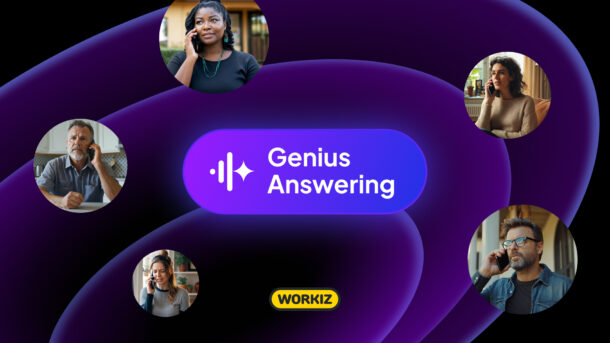Company’s second “Smart Home Data Privacy” survey of 2,000 U.S. homeowners shows increase in smart home tech usage, decreases in confidence about data privacy Copeland, a global provider of sustainable climate solutions, announced today the findings from its second ‘Smart Home Data Privacy’ survey which aimed to determine how both smart thermostat users and non-users Read more
Artificial Intelligence (AI)

Company’s second “Smart Home Data Privacy” survey of 2,000 U.S. homeowners shows increase in smart home tech usage, decreases in confidence about data privacy
Copeland, a global provider of sustainable climate solutions, announced today the findings from its second ‘Smart Home Data Privacy’ survey which aimed to determine how both smart thermostat users and non-users feel about data privacy and the security of their smart home products. While ownership of smart home devices – including smart thermostats, TVs and appliances – are significantly higher than when the study was first commissioned in 2022, homeowners were also more likely to be concerned about data privacy in 2024.

“As we can see by the rise in ownership of smart home products, homeowners are increasingly looking for convenient ways to automate their lives and expand control over their home environments to save on energy costs,” said Lisa Plaggemier, Executive Director of the National Cybersecurity Alliance. “But what’s most concerning is that more than half of homeowners don’t understand how data from their smart thermostat is collected and used – particularly as AI becomes nearly ubiquitous. This should be a resounding call for transparency among smart tech manufacturers.”
While the study shows that homeowners with smart home devices are more concerned than ever about the security of their data (27 percent in 2024 versus 23 percent in 2022), their understanding of and attitudes toward smart tech and data privacy show a critical gap:
- More than half of homeowners (52 percent) don’t have any idea of how data is collected from smart thermostats.
- Homeowners who don’t own a smart thermostat are less likely to be confident that manufacturers use their customers’ data responsibly compared to those who own a smart thermostat (58 percent versus 73 percent), which could be evidence of a barrier to purchase.
- Only 14 percent of homeowners who owned smart thermostats said they researched a manufacturer’s data privacy policy before purchasing a smart thermostat.
And yet, seven out of 10 homeowners are willing to replace their thermostat with one that provides more privacy, with millennials more willing (80%) than other groups.
As a leading innovator in the HVAC industry and the company behind the top-rated Sensi thermostat platform, Copeland was one of the first manufacturers to create a formal privacy pledge in 2022 and has since been a leader in protecting its users’ personal data, never using smart thermostat activity for targeting or advertising purposes. The company has also never sold a user’s personal data to anyone and does not make changes to thermostat settings based on usage assumptions.
“There’s always a role for data, particularly as it relates to a homeowner’s ability to optimize their home comfort and gain energy savings in the process, but those settings are theirs and theirs alone,” said Brendan O’Toole, vice president, smart home and energy management for Copeland. “As demand for smart home products continues to rise, it’s imperative for manufacturers to adequately disclose their privacy policies and educate consumers about the importance of data security,”
For more information about how Copeland’s lineup of Sensi smart thermostats respects and protects consumer privacy and to download the full report, visit sensi.copeland.com/dataprivacy.

Leading field service software empowers businesses with AI dispatcher Jessica Workiz, the leading field service management platform with over 120,000 customers, has announced the launch of its latest innovative AI service, Genius Answering. Genius Answering is the latest innovation in the Workiz Genius suite aimed at redefining after-hours field service operations. Jessica is the smart Read more
Leading field service software empowers businesses with AI dispatcher Jessica
Workiz, the leading field service management platform with over 120,000 customers, has announced the launch of its latest innovative AI service, Genius Answering.
Genius Answering is the latest innovation in the Workiz Genius suite aimed at redefining after-hours field service operations. Jessica is the smart AI dispatcher behind the revolutionary solution. It is the only AI answering service built directly into your FSM (Field Service Management platform).

Jessica handles calls effortlessly. With the unique ability to know everything about your business and your customers, it keeps your business thriving by booking jobs 24/7.
“Imagine never missing a call again, capturing every job opportunity and effortlessly boosting your revenue – even after hours – simply by flipping on the switch to Genius Answering,” said Didi Azaria, CEO of Workiz. “Genius Answering is a game-changer for field service businesses. As a cornerstone of the Workiz Genius suite, it ensures no call goes unanswered, every opportunity is seized, and all tasks integrate effortlessly with your existing processes.”
“Most field service business owners are unaware of the hidden cost of missed calls. An analysis of 150,000 service business calls shows that, on average, 40% of inbound calls go unanswered, and half of those clients have already booked with a competitor by the time they are called back. Now, Genius Answering steps in to help businesses recover this loss, increasing top line revenues by up to 30% simply by implementing Genius Answering inside their Workiz system.”
Offered within the communication suite, Genius Answering goes beyond basic automation by offering continuous availability, industry-specific expertise, personalized customer engagement and comprehensive office support. Jessica seamlessly streamlines operations enhancing overall efficiency by automating up to 80% of call management tasks, from customer support to appointment booking to help capture revenue 24/7.
Say goodbye to the challenges of traditional offshore call centers—like language barriers and cultural disconnects. Jessica, the smart AI dispatcher, delivers flawless, tailored communication designed specifically for the field service industry. With Jessica, you can uphold top-notch service standards, delight your customers and boost revenue—all without the drawbacks of outsourcing.
Genius Answering also helps prevent costly rescheduling by ensuring techs are dispatched efficiently and that customers are available. Its ability to manage multiple tasks simultaneously and drive additional revenue through upselling makes it an asset for field service teams.
“Powered by Jessica, Genius Answering embodies the future of intelligent support, empowering field service teams to capture greater market share and elevate customer experiences with personalized, smart assistance around the clock, ” Azaria said. “At Workiz, our mission is to automate everything but the wrench. Jessica is a major milestone in this journey to revolutionize the way service businesses operate.”
Nick Tellie, owner of We Love Junk in Philadelphia, shares his excitement about how Genius Answering has helped his business turn missed calls into positive revenue.
“Genius Answering with Jessica has been a game-changer for our team,” Tellie said. “In just over a month, Jessica has already booked tens of thousands of dollars in sales. Gone are the days of missed calls slipping into voicemail. Jessica answers instantly, securing jobs that would have otherwise been lost. Her impact on our business has been nothing short of phenomenal.”
For more information on Genius Answering and the Workiz Genius suite, please visit www.workiz.com.

Gone are the days when word-of-mouth and a Yellow Pages listing kept your business calendar full. Digital marketing has always been essential to trades- but unlike that trusty set of wrenches, marketing tools keep changing at lightning speed. In 2024, building trade professionals face a newfound reality: adapt to new trade digital marketing trends, or Read more
Gone are the days when word-of-mouth and a Yellow Pages listing kept your business calendar full.
Digital marketing has always been essential to trades- but unlike that trusty set of wrenches, marketing tools keep changing at lightning speed.
In 2024, building trade professionals face a newfound reality: adapt to new trade digital marketing trends, or risk watching competitors snap up the customers who now live their lives online.
Why Modern Marketing Matters for Trade Professionals
Here’s the thing: amazing technical skills alone won’t fill your schedule anymore.
Today’s property managers and homeowners research everything online before making a call.
They check reviews, watch project videos, and expect instant responses to their questions.
The good news?
Digital marketing doesn’t have to be complex – it just needs to be smart and consistent.
The Real Impact on Local Service Businesses
- More first-time customers finding you through Google searches and maps
- Higher customer retention through automated maintenance reminders
- Better qualified leads that understand your services before calling
- Reduced marketing costs compared to traditional advertising
- Easier tracking of which marketing efforts actually bring in jobs
- Greater ability to showcase your team’s craftsmanship through visual content
- Stronger relationships with property managers and general contractors
Just as you’d invest in quality tools, investing time into understanding trade digital marketing trends is about working smarter, not harder.
You don’t need to master everything at once – even small, consistent steps forward can lead to significant results.

Trend #1: AI, Your Always-On Digital Employee
Remember pulling all-nighters for emergency calls?
AI now handles the initial response, giving you back your sleep schedule.
Small trade businesses are discovering that AI isn’t just for tech giants – it’s becoming as basic as having a business phone number, but way more powerful.
How AI Changes Your Customer Service Game
The beauty of AI in trade services lies in its simplicity.
Think of it as having a super-efficient office manager who works 24/7, never takes breaks, and handles routine tasks without missing a beat.
This digital helper manages the basic stuff while you focus on what you do best: solving technical problems and delivering quality work.
- Smart chatbots answer common questions instantly (like “Do you service my area?” or “What’s your emergency call-out fee?”)
- AI scheduling tools fill your calendar intelligently, considering travel time between jobs
- Automated maintenance reminder systems keep customers on track with regular service
- Lead qualification happens automatically, sending only serious prospects your way
Trend #2: Video Content, Technical Expertise Meets Entertainment
If you’re active on social media, you’ve noticed something fascinating: people are hooked on watching others work.
From satisfying pressure washing videos to complete HVAC installations, viewers can’t get enough of skilled trades in action.
This shift means your everyday work projects can become powerful marketing tools that attract both homeowners and property managers.
What Makes Trade Videos Click
- Before-and-after transformations that showcase your problem-solving skills
- Quick tip videos that help customers with minor fixes
- Time-lapse footage of major installations or repairs
These videos do more than just rack up views – they build trust and show potential customers exactly what makes your work worth every penny.
When people see the complexity behind what you do, they better understand your value.
Platform-Specific Sweet Spots
- Instagram Reels: 30-second job highlights and quick maintenance tips
- YouTube: Detailed how-to guides and longer project walkthroughs
- LinkedIn: Professional case studies targeting commercial clients
- Facebook: Community-focused content and customer success stories
Your knowledge is valuable – and when packaged in bite-sized video content, it becomes irresistible to potential customers who appreciate seeing exactly what they’re paying for.
Trend #3: Local SEO and Google Business Profiles
Remember when customers used phone books to find local contractors?
Today, they ask Alexa or Google to “find a plumber near me.”
Local SEO has evolved beyond basic keywords – it’s now about matching the natural way people search for services, whether they’re typing or talking to their devices.
The New Local Search Landscape
- Voice-optimized descriptions that match how people actually speak
- Service area pages for each neighborhood you cover
- Emergency service keywords tied to specific locations
- Mobile-friendly contact information for quick calls
The closer your online presence matches natural customer behavior, the more likely you’ll show up when they need you.
Google Business Profile Must-Haves
- Current photos of your team and vehicles
- Clear list of services with accurate pricing indicators
- Regular posts about completed projects
- Quick responses to all customer questions
- Updated holiday and emergency hours
- Service area maps showing coverage zones
Your Google Business Profile works like a digital storefront – but unlike a physical location, you can update it instantly to match seasonal demands or highlight emergency availability.
Making these updates regularly signals to search engines that your business is active and reliable.
Expert Insight
According to Bullfinch, a web design Austin studio, “The biggest mistake trades make with local SEO is not updating their service areas when they expand. Add new service areas one at a time, and post content specific to each neighborhood. This gradual approach helps Google understand your true service footprint and ranks you better for those areas.”
Trend #4: Mobile-First Services
Your customers manage their entire lives through their phones – from ordering groceries to controlling their thermostats.
They expect the same convenience from their trade service providers, and the smart ones are delivering.
The Mobile Money Movement
Mobile payment systems aren’t just convenient – they get you paid faster and reduce those awkward payment conversations.
What Customers Expect From Mobile Services
- Instant quotes through text or app messaging
- Digital invoices they can pay with one tap
- Real-time project updates with photos
- Easy scheduling and rescheduling options
- Quick access to service history
- Simple ways to approve additional work
- Video chat options for initial consultations
- Digital signatures for contracts and approvals
The beauty of mobile-first service isn’t just about making things easier for customers – it’s about creating a paper trail that protects everyone and keeps projects moving smoothly.
When everything is documented in an app, there’s no more “he said, she said” about what was agreed upon.
The Time-Saving Reality
Mobile tools cut administrative time by up to 75%.
Instead of spending evenings catching up on paperwork, you can focus on growing your business or – imagine this – actually taking time off.
Trend #5: Data-Driven Personalization, Making Every Customer Feel Like Your Only Customer
Every interaction with your customers creates data, and that data tells a story.
Smart trade businesses are using these stories to predict needs, prevent problems, and show customers they’re paying attention.
- Seasonal patterns reveal perfect timing for maintenance offers
- Usage habits inform personalized service recommendations
- Customer preferences shape communication styles
- Service histories guide custom maintenance schedules
The Power of Prediction
When you know a customer’s water heater is nearing the end of its life, or their HVAC system typically needs attention in early spring, you can reach out at exactly the right moment.
This isn’t just good business – it’s great service that customers appreciate.
Smart Data Use in Action
- Birthday discounts on annual maintenance plans
- Weather-triggered reminders for seasonal services
- Custom portal access for property managers
- Personalized video updates on long-term projects
The Human Touch in Digital Form
Data-driven personalization actually makes your service more human, not less.
By remembering every detail about your customers’ systems and preferences, you’re showing them the kind of attention that used to only come from the neighborhood handyman who’d served their family for decades.
Making Digital Marketing Work For Your Trade Business
Here’s the simple truth: you don’t need to implement everything at once.
Start with what makes sense for your business right now.
Maybe that’s setting up a basic AI chatbot for after-hours inquiries, or creating a few quick videos showing your team’s expertise.
The key is picking one thing, mastering it, and then moving on to the next.
Your Next Steps
Pick the trend that solves your biggest current challenge.
If you’re missing after-hours calls, start with AI chat.
If customers don’t understand the value of your work, focus on video content.
If you’re struggling to get found online, prioritize local SEO.
The beauty of digital marketing is that you can add pieces one at a time, testing what works best for your specific situation and customer base.
The trades aren’t just changing – they’re leading the way in how local service businesses use technology to improve customer experience.
Your skills and knowledge are more valuable than ever – now it’s just about making sure the right people can find you when they need you.

Contractors and Technicians Embrace AI to Advance Skill Sets and Grow Businesses with Solutions Announced at ServiceTitan’s Annual User Conference ServiceTitan, a leading software platform built to power the trades, today announced additions to its AI-powered technology for residential and commercial contractors. The latest solutions unveiled at Pantheon 2024 include a transformative AI assistant that will work Read more
Contractors and Technicians Embrace AI to Advance Skill Sets and Grow Businesses with Solutions Announced at ServiceTitan’s Annual User Conference
ServiceTitan, a leading software platform built to power the trades, today announced additions to its AI-powered technology for residential and commercial contractors. The latest solutions unveiled at Pantheon 2024 include a transformative AI assistant that will work across ServiceTitan’s suite of products, along with new applications for sales and call centers. Powered by Titan Intelligence, the company’s own purpose-built AI solution for the trades, these innovations empower contractors to automate, predict, and optimize their entire business.

“At ServiceTitan, we’re empowering our customers to do more than just unlock efficiency – we’re giving them the comprehensive tools they need to thrive in a rapidly-changing world, where AI is transforming nearly every industry,” said Vahe Kuzoyan, president and co-founder at ServiceTitan. “I’m thrilled to be expanding our suite of technology to equip our customers with the tools they need to work smarter, communicate efficiently, sell more effectively, and grow faster.”
The new features and solutions introduced at Pantheon 2024, ServiceTitan’s annual user conference, include:
-
Contact Center Pro is an always-on, AI-driven contact center for the trades that simplifies multiple communications channels to increase revenue, lower costs, and improve customer service. Powered by Titan Intelligence virtual agents, it’s a multi-channel solution that brings phone, email, web, and social into a Universal Inbox, with guidance from a virtual assistant.
-
SalesPro is an AI-powered solution to help technicians excel at sales. As AI-powered sales tools become more common, SalesPro is the first to focus on the trades. Most technicians are not sales experts but do much of a firm’s selling by necessity due to their regular customer interactions. Powered by Siro, SalesPro helps technicians gain confidence by analyzing their interactions through AI and suggestions, utilizing expert training content. It also connects technicians with peer-to-peer coaching to unlock their inner sales pro.
-
TI Assist revolutionizes customer decision-making across ServiceTitan by bringing AI, predictive insights, risk analysis, personalized recommendations, and deep automation to ServiceTitan with intuitive, easy-to-use TI personal assistants. Across roles and responsibilities, all users can use TI Assist to do their jobs more efficiently.
“At ServiceTitan, we are obsessed with making our customers as successful as possible,” said Ara Mahdessian, co-founder and CEO of ServiceTitan. “To do this, we continually strive to build innovative software, powered by AI, to help them run and grow their businesses. By delivering actionable insights and automated technology, we help contractors stay focused on what they do best—serving their customers and providing top-tier service, all while unlocking new opportunities for revenue growth and sustained profitability.”
To learn more about all of the new features and announcements at Pantheon 2024 visit the Pantheon Live Blog.

Even as concern around white-collar jobs grows due to AI and economic uncertainties, Jobber’s report reveals hesitancy among Gen Zs to pursue trades careers Jobber, the leading provider of home service software, today released The Annual Blue-Collar Report: Gen Z and the Trades Need Each Other. The report, based on survey responses from 1,000 students in the Read more
Even as concern around white-collar jobs grows due to AI and economic uncertainties, Jobber’s report reveals hesitancy among Gen Zs to pursue trades careers

Jobber, the leading provider of home service software, today released The Annual Blue-Collar Report: Gen Z and the Trades Need Each Other. The report, based on survey responses from 1,000 students in the U.S. aged 18-20, provides insight into how Gen Z navigates education and career choices, as well as offers solutions on how to inspire and encourage younger generations to consider taking advantage of all that blue-collar careers have to offer.
According to The Annual Blue-Collar Report, 76% of Gen Zs agree there is a stigma associated with going to vocational school over a traditional four-year university. This reality threatens our homes, economy, and the livelihoods of younger generations.
“If you own a home, you have a problem,” warns Sam Pillar, CEO and co-founder of Jobber. “While there is some renewed interest among the younger generation to pursue blue-collar careers, there’s still far too much work homeowners need done, and not enough workers to do it. We need to do a better job showing Gen Z how incredible the opportunities in the trades are, and encouraging them to consider that path.”
The U.S. housing stock is aging rapidly, with the median age of homes reaching 40 years. This is a critical problem as the U.S. is experiencing a labor shortage across most industries as labor force participation declines and the workforce ages and retires. In addition, the U.S. Bureau of Labor Statistics states that employment demands in trade industries are often greater than or pacing the 3% average of all occupations, representing not just a gap, but a growing chasm.
Key findings from the report provide deeper insights into why Gen Z is not pursuing blue-collar careers and how society can encourage younger generations to consider them. Despite the growing stigma and misconceptions that Gen Z has, The Annual Blue-Collar Report clearly shows that they actually do want blue-collar careers, and just don’t know it yet.
The “American Dream” needs a blue-collar rebrand
Gen Z has been taught to measure success through a white-collar lens, but AI, the economy, and layoffs are changing their minds. Their concerns around white-collar careers are clear.
- One-third (33%) of Gen Z say that white-collar desk jobs are less stable today than they were for their parents’ generation.
- 41% of Gen Z agree that the potential for AI to replace jobs has made it harder to achieve the “American Dream” and 46% believe there will be fewer future job opportunities as a result.
- 70% of Gen Z say they are not optimistic about the future of the economy.
- When asked what would make a trade career more appealing, Gen Z described what blue-collar professions already offer, including flexible work hours (73%), job stability (61%), and overtime pay (58%).
Gen Z’s biggest career influences are letting them down
Parents have blue-collar blindness, schools deserve a failing grade for blue-collar education, and Hollywood is doing hard work dirty.
- Family (51%) was identified as the biggest influence on Gen Z and the careers they chose to pursue by a significant margin.
- 61% of Gen Z say their parents haven’t spoken to them about vocational school or told them not to consider it.
- Just 17% of Gen Z say they have been educated on the benefits of vocational training following high school graduation. This was significantly lower than bachelor’s degree, community college, military service, and entrepreneurship.
- More than a third (35%) of Gen Z say television shows and movies have influenced the careers they want to explore and 47% describe trade professionals as being generally portrayed negatively (incompetent, unhealthy, and/or unhappy) in shows and movies.
We simply need more women in the trades
While many workforces have evolved to accommodate the modern gender distribution of labor, the trades have yet to establish this balance.
- Nearly half (48%) of Gen Z agree that women are discouraged from pursuing trade careers from a young age.
- 58% of Gen Z say that women face more discrimination within trade careers—compared to other career options—with the majority of women (68%) believing this compared to men (47%).
In addition to survey data and insights, The Annual Blue-Collar Report offers testimonials from people like 27-year-old commercial and residential electrician, Lexis Czumak-Abreu, who attests to the benefits of blue-collar work: “I studied pre-med in school, intending to become a surgeon but decided to become an electrician instead. Many people in my family are electricians, including my dad. The salary is great, the hours are stable, and the work is very gratifying!”
Finally, The Annual Blue-Collar Report highlights 10 specific calls to action for the general public, blue-collar professionals, policymakers and educators, and the media to help connect the dots between Gen Z’s fears and desires and the blue-collar opportunity in front of them, as well as eliminate the existing harmful stereotypes.
To access The Annual Blue-Collar Report Powered by Jobber, visit jobber.com/blue-collar.
